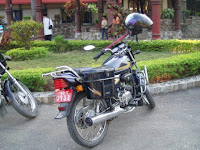Kapilavastu/kapilavatthu/Kapilvastu all these name are the same place. Prince Siddhattha (later became Buddha) spent the first pat of his life here.
Kapilavastu was destroyed before Buddha went for Mahaparinibbhana. When King Pasenadi wanted to extend and strenghten his influence, he decided having his son marry the Sakyan noble woman. The noble Sakyan, Mahanama fathered a daughter named Vasabhakhattiya by a slave woman (treated as a noble woman). He married this daughter to King Pasenadi's son. Then Vidudabha was born. Vidudabha was not encouraged to visit his Sakyan family when he grew up by his mother.
Somehow he made decision to proceed his thought. He received an unpleasant condition of welcoming, then he left. Suddenly he recalled that he forgot to take his weapon, he went back to claim it. The thing he saw was a slave woman washing and purifying the seat of Vidudabha with milk. It's was a down look on his status. He asked the slave about why she did all this kind of stuff. The woman slave told him that he was an off spring of a slave. He vowed in revenge that when he was a king, he would washed the place with blood of thiers' heart. Many Sakyans died and the survive one ran to the hill side and built another town named Mariyanagara.
When Fa Hien reached Kapilavastu, it had been desolated. Only some monks and few families of c0mmon people.
When Huien Tsiang reached, it was still the same thing. The surrounding had been the agriculture land.
The locations given by Fa Hien and Huien Tsiang were different.
Some scholars claimed that Tilaurakot, 22 km northwest of Lumbini as Kapilavastu.
Somehow an English landlord found a huge stone box about 669 kg at Piprahwa (India side). Discoveed so many values items, dishes,vases...etc. The second casket had the inscription on, it was the earliest decipherable writing in India. There were also the believed to be Buddha's burnt bones casket, and also the closed relatives of Buddha burnt bones.
Excavation at Piprahwa started in January of 1971, after Ven Dharmakirti wrote a letter to Mrs Indira Ghandi about the appealing for the excavation and restoration of Piprahwa. Then immediate action had been taken when the director general of the Archaeological Survey India received the letter.Excavation at Piprahwa started in January of 1971, after Ven Dharmakirti wrote a letter to Mrs Indira Ghandi about the appealing for the excavation and restoration of Piprahwa. Then immediate action had been taken when the director general of the Archaeological Survey India received the letter.
Later found that the remain of Kapilavastu are in 2 places : Ganwaria was the actual town of Kapilavastu and Piprahwa was the religious centre. The distance between this 2 places about one km.
The main stupa was built in 5 century BC found from the excavation. The date and contents which found in the casket almost certain that the bone were the remains of the Buddha.
All these items were kept in the National Musuem in New Delhi.







Then we also visited to Mahinda vihara in Kapilavastu, the district of Siddartha Nagar district.
The village life near to the temple.
After visited the Kapilavastu, we continued our journey to Bhairahawa then Lumbini. On the way we saw the daily life of the border poeple of the 2 countries.
Then we reached the Lumbini Nirvana hotel. Mom and I enjoyed the environment very much. It was the 3rd time we stepped our legs on the land of Nepal. We had our lunch in the hotel.















No comments:
Post a Comment